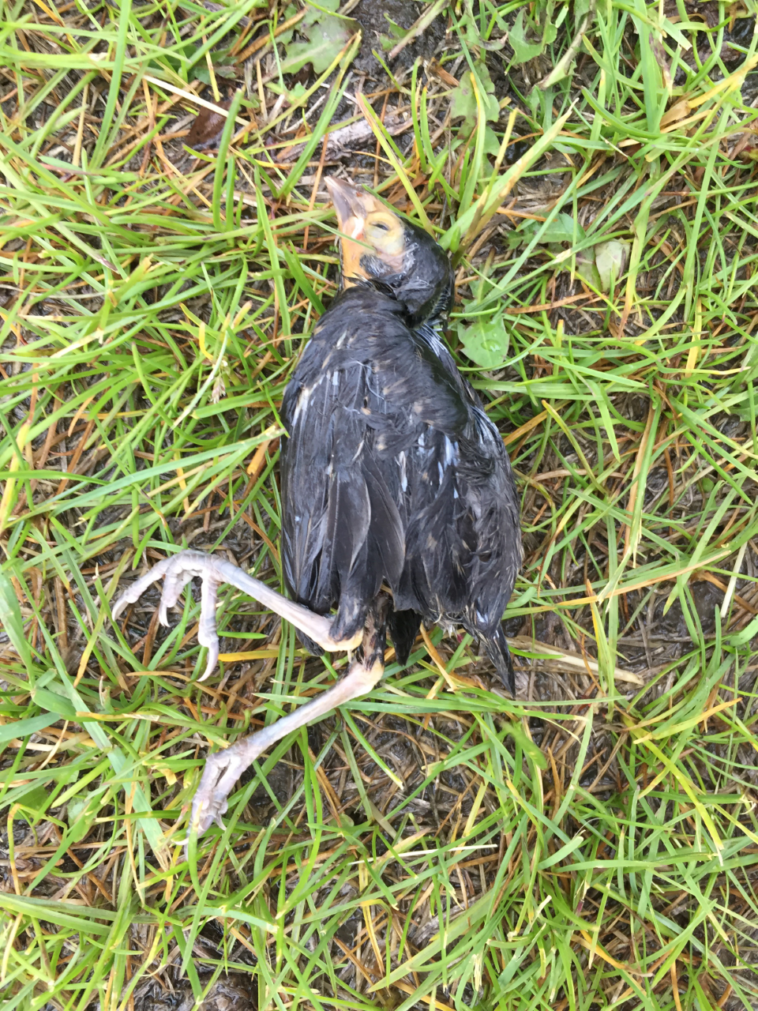h2>Dating : Unconditional Focus on Building a Resilient Nest
The deaths of many baby red-winged blackbirds brought me sorrow and appreciation.
I looked down at the tiny, dead, red-winged blackbird. I had used a makeshift net to lift its lifeless body out of the reeds. Perhaps I should have left it alone, but I had to know. All I could see were several dark clumps on a patch of floating reeds and sticks. So, I pulled one out.
(Play the audio below to accompany your reading of this article)
Most nights after dinner, my fiancé, Violet, and I would walk around the stormwater pond near our home. Our favorite spot was where four patches of reeds stood in the northwest corner of the half kilometer long pond. Each expanse of cattails was twenty to thirty feet away from the next. When the sun rose, its rays would spill over that corner of the pond. When the sun fell, the light still washed the area. Those waters were blessed with more sunlight than the rest of the basin, and so most of the wildlife activity resided there. Plentiful were the birds, ducks, fish, and insects in that beautiful section of earth.
The red-winged blackbirds caught our attention most often. In the spring, we watched dozens of males, black with red patched wings, chase the females, brown with red-tinged wings. As summer came along, we watched male and female pairs carry nesting material into the reeds. By May, each copse of water grass housed a family of red-winged blackbirds. All the other red-winged blackbirds left the area.
Violet loved to bird watch, and so I would follow her lead. She showed me how defensive red-winged blackbirds were of their dens. I had never noticed before. The males would always perch on a nearby tree or lamp post, watching for predators. When we would approach the reeds, they would swoop down and hover in front of our faces, whistling and squawking. They would also fly circles around our heads. Sometimes the female birds would join in the harassment, trying to push us away from their homes.
Violet had a way of exposing phenomena that would otherwise elude me.
In June we could hear the chirping of baby birds from the edge of the water.
Then the rains came, and one June day the water fell in relentless sheets from the sky for ten hours.
After dinner that day the rain stopped. Violet and I went for our evening walk, not thinking of the effects of the showers. We reached the pond and found the water had risen four or five feet from its average level, submerging the perimeter rocks.
“Oh shit, the blackbird nests,” I said. Violet was silent for a moment. She loved birds and did not want to think of the nests underwater.
“Maybe they’re okay,” there was doubt in her voice.
As we came around to the side of the pond where the reeds were, we could only see the top foot or two of the grasses. Before the rain, the cattails stood five or six feet out of the water.
“The nests are underwater. Unless they found a way to save their chicks, they will have drowned.” I said, straight to the harsh truth. Violet sighed, hoping I was wrong.
At the first set of reeds, the mother and father blackbirds flew from one perch to another, chirping and looking down at the water. When we came close, the birds flew around our heads but quickly returned to looking for their babies.
At the next copse of reeds, the mother and father birds did not even notice us. They were looking down, seeming exhausted. At those two areas, we looked into the rushes but could not see any baby birds. We moved on to the third bunch of cattails.
There, after a moment, we spotted where the nest had been. Three dark shapes lay on a floating bunch of reeds, grasses, and twigs. They were seven feet away from us and difficult to see. Violet and I stood next to each looking at the shapes. The mother and father birds flew around us, sometimes hovering in our faces. The palpable aura of death held us there.
Violet looked into the reeds to our left.
“Hey! One is alive,” she said. One lone bird, only a little larger than its dead siblings, perched on a single floating cattail. There was a wind rushing out of the field behind us and slamming into the bird. We thought that the wind might push it off its perch into the water; drowning the bird. We decided we could not leave it there and ran home. We taped a food strainer to a wooden rod.
When we got back, the bird was no longer on the single read. We thought we were too late. After a moment we realized it was in a different place. The baby was on a sturdier set of sheltered reeds, further away from the bank. Either it could fly, or mama and papa moved it with their talons. We changed our minds about intervening.
That was when my boyish curiosity took over, and I used our makeshift net for fishing out one of the dead birds. As I said, I had to know.
The red-winged blackbirds only had a few choices in how to build their nests. They always built within cattails, grasses, low bushes, or rushes; almost always over water. In those environments, they could build high and be more vulnerable to the winds and predatory birds. Or, they could build low and be more susceptible to the water.
These Red-winged blackbirds built with unconditional focus. No matter the pressures of the environment, they made nests with their ancient instinctual knowledge and protected their young where they could. These birds near our home built close to the water to maintain resilient, sheltered homes, but the rain took their children.
Over the next few months, we noticed several other young blackbirds flying around the reeds. More had survived. That was the norm for most animals in the wild, wasn’t it? Only under rare circumstances would a mother and father see each of their children flourish; most would die in the wilderness.
Then there were modern humans, set aside from nature in some ways. In many places, it was the norm for parents to see their children age and have children of their own.
We recently found out that Violet was pregnant, and so I wondered how we would build a nest for our baby. Granted, we would not have to worry about shelter, clothing, or food. Our jobs would provide all that. However, we would have to provide guidance; maybe that more than anything. Just as the red-winged blackbirds guided their surviving young, we would have to teach independence to our child.
For many people, building their nests was about choosing how to guide their children. Of course, there were still many places where predators and insects may kill children. Either way, humans focus on crafting resilient nests just as the birds do.
Violet and I would have to strike a balance between protection, low in the reeds, and exposure, high in the grasses, to teach our child competence, confidence, and independence. An unconditional focus on building a resilient nest where all of us could communicate, express, learn, and flourish would be essential.



